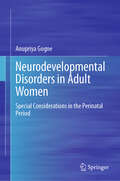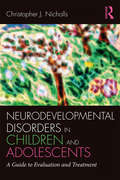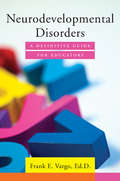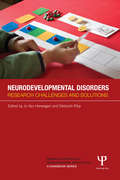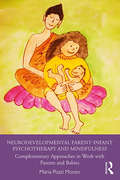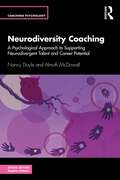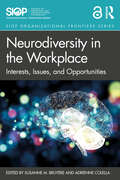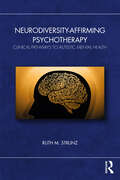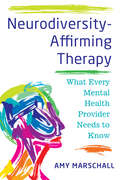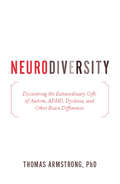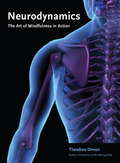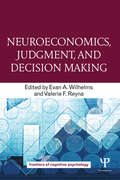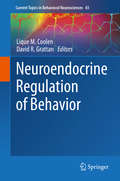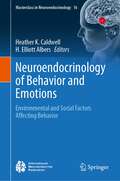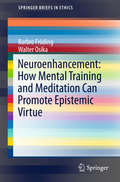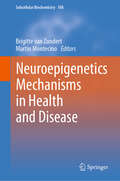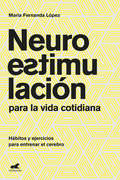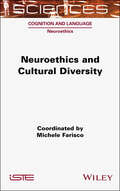- Table View
- List View
Neurodevelopmental Disabilities and Employment: Helping Learners Prepare for Social Demands in the Workplace
by Dorothea C. LermanThis book provides a comprehensive curriculum on essential job-related social skills that will aid educators, job coaches, behavior specialists, behavior analysts, and other professionals to improve employment outcomes of individuals with autism spectrum disorder and other neurodevelopmental disabilities. The curriculum guides instructors through an objective behavioral assessment of critical, social, and problem-solving skills, and provides a framework for identifying individualized, effective teaching strategies using a response-to-intervention approach. This book will present a vocational social skills curriculum that is divided into two parts: The Vocational Social Skills Assessment Protocol (VSSA) and the VSS Intervention Protocol (VSSI). Chapters explore skills such as conducting the VSSA and VSSI, collecting data for the VSSA, and interpreting VSSA and VSSI results. With a focus on evidence-based interventions that may be practical for supervisors to implement on the job site, this curriculum is designed to foster positive relations in the workplace and promote long-term employment.
Neurodevelopmental Disorders in Adult Women: Special Considerations in the Perinatal Period
by Anupriya GogneThis book elaborates on Neurodevelopmental Disorders (NDD) and their treatment in adult women with a special focus on the unique clinical presentation of these problems during the Perinatal period. Problems related to chronic, untreated NDD during adulthood are viewed through the lens of pregnant and postpartum mothers to highlight unique struggles as their family unit expands after having children. The content is based on the author&’s clinical experience with mothers under her psychiatric care between 2017-2024 at an outpatient practice, affiliated with Brown University. Comorbid psychiatric problems such as anxiety, mood disorders, trauma and substance use disorders are also reviewed. In addition to sharing clinical anecdotes, the author presents a consolidated review of scientific literature on the subject. I believe that this book can be an important addition to scientific literature at this time, when Neurodiversity is being explored and accepted more in society and we are more receptive to improving women&’s mental health. Afflicted mothers as well as their treatment providers have conveyed to me the profound relief on finally getting accurate diagnosis and treatment for NDDs. Several books have been published documenting the unique presentation and treatment interventions for ADHD and Autism in women, however, this will be the only book addressing symptomology and treatment interventions for NDD specifically during the perinatal period. I have seen how successful long-term treatment with a specialized team of mental health professionals can significantly improve the quality of life not just for the mother but also, for the entire family unit. The book will be divided into two parts: Part 1- Clinical Manifestations and Symptomology in Adult Women with NDD In the first part of the book, I plan to discuss the approach to diagnosis of Neurodevelopmental Disorders in General Adult Psychiatry and understand reasons for missed diagnosis, especially in females. I will outline my diagnostic and therapeutic approach, conceptualizing NDDsymptomology as variations of higher brain functioning rather than categorization of these symptoms as a &“disorder,&” and contemplating potential evolutionary advantages to neurodiversity. Based on my clinical practice, I will discuss tools for clinical assessment, including referral for neuropsychological testing and its utility in adults. In addition to the DSM-5 diagnoses, I will also propose conceptualizing difficulties in functioning and subjective distress in terms of symptom domains (executive dysfunction, hyperactivity/impulsivity, sensory overload and emotional regulation) as reflected in day-to-day functioning and social interactions in the adult life of women. Also, differential diagnoses including Obsessive Compulsive Disorder, Bipolar disorder, Post Traumatic Stress Disorder (PTSD), and personality disorders will be discussed, addressing the puzzling symptom overlap as well as genetic predisposition between these psychiatric illnesses and neurodevelopmental disorders. I will describe this association using clinical case examples and, later in the book, propose the inclusion of trauma-based interventions in treatment of Neurodevelopmental Illnesses in adult women. Lastly, comorbid substance use will be addressed. I will highlight struggles related to complex psychopathology and dual diagnosis. Given my training in Addiction Psychiatry, one of my goals is also to reduce stigma and apprehension about prescribing controlled medications in patients with history of substance use disorders. Part 2- Perinatal perspective on NDD Part 2 will have a specific perinatal focus starting with a detailed description of predisposing factors (Behavioral/Social, Psychological and Biological factors) for distress in Mothers with
Neurodevelopmental Disorders in Children and Adolescents: A Guide to Evaluation and Treatment (Clinical Topics in Psychology and Psychiatry)
by Christopher J. NichollsNeurodevelopmental Disorders in Children and Adolescents provides an innovative perspective on developmental disorders in youth, one focused on embracing and working with the "messiness" and many variables at play in child and adolescent development. The volume’s approach is aligned with the NIMH Research Domain Criteria project, which hopes to move away from categorical diagnosis toward multidimensional analysis. Each chapter focuses on a particular aspect of development, cluster of diagnoses, or clinical concern. The book also emphasizes humility, an awareness of diversity and difference without stigma, and support for collaborative and integrative healthcare. This is an essential volume for practitioners hoping to improve how they evaluate and treat developmental disorders in children.
Neurodevelopmental Disorders: A Definitive Guide for Educators
by Frank E. VargoFrom autism to ADHD to learning disabilities, a guide for all teachers to this constellation of disorders. Developmental deficits in learning and communication in young children are defined as neurodevelopmental disorders. This constellation, newly defined in the DSM-5, represents a range of issues that educators must address. Neurodevelopmental Disorders: A Definitive Guide for Educators provides extensive and practical information to a range of professionals, and to all others who are interested in the complex and often misunderstood disabilities that fall within the general medical and psychological diagnostic categories of neurodevelopmental disability. Noted psychologist and educator Dr. Frank E. Vargo provides a comprehensive overview of neurodevelopmental deficits and disabilities, as well as of their related learning and cognitive processes, with a strong focus on educational considerations, applications, and relevance across academic areas and with a mind to global educational models. Well researched and accessibly written, this book is an up-to-date and authoritative reference to all of the educational and clinical topics in the diagnostic categories of neurodevelopmental disorder. This informative book will provide a primary reference source for all educators, school and clinical psychologists, clinical mental health counselors and therapists, special education and medical professionals, and parents of children with special needs.
Neurodevelopmental Disorders: Research challenges and solutions (Research Methods in Developmental Psychology: A Handbook Series)
by Jo Van Herwegen Deborah RibyInterest in the field of neurodevelopmental disorders has grown exponentially in recent years across a range of disciplines, including psychology, psychiatry, education and neuroscience. The research itself has become more sophisticated, using multidisciplinary methods to probe interdisciplinary questions. Neurodevelopmental Disorders: Research Challenges and Solutions provides a thorough overview of the key issues involved in researching neurodevelopmental disorders. The volume includes 14 chapters, arranged over three sections. Chapters in the first section address general research challenges for the study of neurodevelopmental disorders. The second section draws upon specific disorders (such as Williams syndrome, Autism Spectrum Disorders, Down Syndrome, Fragile X Syndrome, ADHD, and Language Disorders) to consider the syndrome-specific issues or challenges that may be crucial to advancing our understanding of aspects of cognition and behavior associated with them. The final section considers how research evidence may be translated into practice to begin making an impact upon the lives of individuals who have neurodevelopmental disorders and their families. Each chapter in the book also includes ‘practical tips’ for either conducting research with individuals who have neurodevelopmental disorders or considering wider practical issues. The book will be indispensable reading for advanced students, researchers, and practitioners in the fields of developmental psychology, developmental psychopathology, special needs education, neuropsychology, and neurodevelopmental disorders.
Neurodevelopmental Parent-Infant Psychotherapy and Mindfulness: Complementary Approaches in Work with Parents and Babies
by Maria Pozzi MonzoThis innovative book explains and introduces the use of mindfulness in therapeutic work with parents and babies, covering issues such as feeding, crying, sleeping and relating, as well as other developmental challenges which affect family life, as practiced in both clinical sessions and in the home. The book is divided into two parts. Part 1 introduces: (1) what parent-infant psychotherapy is, its origin and evolution; (2) mindfulness, which consists in paying attention in a purposeful way in the present moment and not judgementally; and (3) the development and maturation of the brain and nervous system and how they are affected by the environment in utero and after birth. Part 2 then goes on to explore a range of topics such as parental mental illnesses, immigration, dislocation, loss, guilt, substance misuse, abuse, post-natal depression, congenital malformations and the role of fathers. It describes how these factors impact the parental relationship with, and the healthy development of the infant, drawing from relevant research to demonstrate the effectiveness of parent-infant psychotherapy and mindfulness. The practice of psychoanalytic psychotherapy aided by mindfulness is a useful intervention for distressed families with infants, while a mindful approach to oneself and one’s baby can ease parental anxiety and free-loving capacities. Neurodevelopmental Parent-Infant Psychotherapy and Mindfulness is an essential resource for clinicians and researchers working on parent and infant relations and will also appeal to curious new or future parents.
Neurodharma: New Science, Ancient Wisdom, and Seven Practices of the Highest Happiness
by Rick Hanson PhDLOS ANGELES TIMES BESTSELLER • &“An easy-to-follow road map for creating day-to-day inner peace in today&’s increasingly complex world.&”—Lori Gottlieb, MFT, New York Times bestselling author of Maybe You Should Talk to SomeoneThroughout history, people have sought the heights of human potential—to become as wise and strong, happy and loving, as any person can ever be. And now recent science is revealing how these remarkable ways of being are based on equally remarkable changes in our own nervous system, making them more attainable than ever before. In Neurodharma, the follow-up to his classic Buddha&’s Brain, New York Times bestselling author Rick Hanson, PhD, not only explores the new neuroscience of awakening but also offers a bold yet plausible plan for reverse-engineering peak experiences, sense of oneness, and even enlightenment itself. And he does so with his trademark blend of solid science and warm encouragement, guiding you along this high-reaching path with good humor, accessible tools, and personal examples. A groundbreaking yet practical book, Neurodharma shares seven practices for strengthening the neural circuitry of profound contentment and inner peace—qualities that offer essential support in everyday life while also supporting the exploration of the most radical reaches of human consciousness. Step by step, this book explains how to apply these insights in order to cultivate unshakable presence of mind, a courageous heart, and serenity in a changing world. The breakthroughs of the great teachers are not reserved for the chosen few. Dr. Hanson shows how we can embody them ourselves in daily life to handle stress, heal old pain, feel at ease with others, and rest in the sense of our natural goodness. The Buddha didn&’t use an MRI to become enlightened. Still, 2,500 years after he walked the dusty roads of northern India, neuroscientists are discovering the mechanisms of the brain that underpin the Buddha&’s penetrating analysis of the mind. With deep research, stories, guided meditations, examples, and applications, Dr. Hanson offers a fascinating, inspiring vision of who we can be—and an effective path for fulfilling this wonderful possibility.
Neurodiverse Couple Therapy: A Practical Guide to Brain-Informed Care
by Kelli Murgado-WillardThis inclusive and comprehensive manual equips marriage and family therapists with the skills to identify, support, and provide Brain-Informed Care to neurodiverse couples. Written from Murgado-Willard's unique perspective as a neurodivergent couple therapist, this book addresses a knowledge gap in the couple counseling field and helps therapists develop and maintain an ethical standard of care for neurodiverse couples. The text also introduces a new style of couple therapy for use in private practice settings: Brain-Informed Neurodiverse Couple Therapy (BINCT). Chapters begin by providing some historical context of neurodiversity before offering invaluable training on best practices, assessment, treatment planning, and using non-ableist, practical interventions for this population. Case studies that present a variety of sexual identities are featured throughout as well as a glossary of key terms and checklists that therapists can use immediately in their practice. This book aims to implement a paradigm shift in the field and is essential reading for therapy students. It is invaluable reading for practicing therapists that did not receive training on working with neurodiverse clients.
Neurodiversity Coaching: A Psychological Approach to Supporting Neurodivergent Talent and Career Potential (Coaching Psychology)
by Almuth McDowall Nancy DoyleNeurodiversity Coaching demystifies the themes and assumptions affecting neurodivergent coachee experiences at work, whilst at the same time exploring the necessary safeguards required for working with this vulnerable group.The book supports existing coaching practitioners, managers and community leaders to understand the essentials of neurodivergence, a term which encompasses ADHD, autism, dyslexia, dyspraxia and Tourette Syndrome, and how these diagnoses require specific coaching approaches to support individuals to thrive at work. This book is practically focused on the “how”, sharing coaching exercises and activities that have been evaluated and researched by authors with extensive experience in the field. Grounded in coaching psychology theory, those with existing knowledge will be able to transfer their skill set to the neurodiversity context and those who are considering learning more about coaching can be signposted to essential knowledge and skills.Neurodiversity Coaching will be suitable for independent coaching practitioners and internal organisational coaches and managers seeking a coaching approach.
Neurodiversity Coaching: A Psychological Approach to Supporting Neurodivergent Talent and Career Potential (Coaching Psychology)
by Almuth Mcdowall Nancy DoyleNeurodiversity Coaching demystifies the themes and assumptions affecting neurodivergent coachee experiences at work, whilst at the same time exploring the necessary safeguards required for working with this vulnerable group. The book supports existing coaching practitioners, managers and community leaders to understand the essentials of neurodivergence, a term which encompasses ADHD, autism, dyslexia, dyspraxia and Tourette Syndrome, and how these diagnoses require specific coaching approaches to support individuals to thrive at work. This book is practically focused on the “how”, sharing coaching exercises and activities that have been evaluated and researched by authors with extensive experience in the field. Grounded in coaching psychology theory, those with existing knowledge will be able to transfer their skill set to the neurodiversity context and those who are considering learning more about coaching can be signposted to essential knowledge and skills. Neurodiversity Coaching will be suitable for independent coaching practitioners and internal organisational coaches and managers seeking a coaching approach.
Neurodiversity For Dummies
by John Marble Khushboo Chabria Ranga JayaramanA quick and easy way to understand neurodiversity as written by neurodivergent people and our families Neurodiversity For Dummies is your essential guide in understanding neurodivergent conditions like autism, ADHD, dyslexia, and more. This quick and easy guide is perfect for anyone needing to know more about neurodiversity. And that’s all of us—because recent estimates say that 15-20% of the world’s population have some form of neurodivergence. Your life is filled with neurodivergent people that you know and love, whether you realize it yet or not. It’s time to learn to support and include the neurodivergent among us, and to understand how neurodiversity impacts society and the workplace. This is for the neurodivergent person wanting to thrive in life, for parents and caregivers seeking success for their child, and for teachers who are working to make a difference in their students’ lives. Filled with practical advice, Neurodiversity for Dummies also provides a helping hand to service providers, assistance for workplace managers and colleagues, and understanding for family members and friends. Imagine a world where we all understood ourselves better and appreciated more deeply the differences in others. No matter how your own brain thinks, Neurodiversity for Dummies is for you. Check out this jargon-free introduction for an essential overview. Explore the Spectrum of Neurodiversity: Understand in plain language the world of autism, ADHD, dyslexia, and other neurodivergent conditions. Unlock Hidden Talents: Move yourself beyond common myths and misconceptions to discover how neurodiversity actually works. Learn how neurodiversity has always been with us, why society needs neurodivergent traits, and how neurodiversity can be a wellspring of innovation, creativity, and out-of-the-box thinking. Discover Yourself: Whether you are a neurodivergent person or not, learn how to understand your own normalcy, advocate for your needs, and build meaningful connections with those who think and experience the world differently than you. Change the World Around You: Be empowered through simple steps you can take to create inclusive environments for neurodivergent individuals in your school or workplace. Uncover proven strategies that cultivate a culture of acceptance and respect, where the unique perspectives of all individuals are valued and celebrated. We believe in providing parents with better supports, empowering individuals with information, and shaping a world where we are all seen and understood. With an author team composed of neurodivergent individuals and parents writing together, Neurodiversity for Dummies is an example of the power of neurodiversity when put into action. It’s why we wrote this for you. Don’t miss your chance to embark on this transformative journey. Order your copy of Neurodiversity for Dummies now to better understand yourself and others, and to join the movement that is revolutionizing how we understand and support the diversity of the human mind.
Neurodiversity Works: A Study Of Employees With ADHD, AS And PTSD
by Sarah E. H. BabineauThis research paper focuses on the experiences of employees with hidden disabilities in the workplace. Three cognitive disorders were studied, Attention Deficit Hyperactivity Disorder, Asperger's Syndrome, and Post-Traumatic Stress Disorder. Literature by experts on these subjects is reviewed and analyzed. Participants then describe their feelings and experiences in the workplace as they related to their conditions, and the two are juxtaposed in a final discussion. Emergent themes that resulted from the lines of questioning included the role played by manager and coworker support, accommodations under ADA and ADA Amendments Act, working environment, employee attitude, and whether the participants felt they had been treated fairly. Participants were asked to contribute to a quantitative survey instrument as well as a qualitative survey instrument that encouraged them to tell their stories in their own words. In some cases, these stories serve to help identify best practices in the workplace, and some serve to illustrate the obstacles and level of conflict, sometimes bordering on cruelty, that can exist for those with ADHD, AS and PTSD if negative behaviors and attitudes in the workplace are left unchecked. Human Resources practitioners and managers were also queried on the subject to obtain a rounded and full view of the challenges employees with these three hidden disabilities face, as well as those of the people who manage them.
Neurodiversity in the Workplace: Interests, Issues, and Opportunities (SIOP Organizational Frontiers Series)
by Susanne M. Bruyère Adrienne ColellaNeurodiversity in the Workplace presents a timely and needed perspective on the role and responsibility of employers and those working to increase the effectiveness of workplace practices to examine the many ways we preclude large segments of the population from employment; minimizing opportunities for building a truly inclusive work environment. This collection provides an opportunity to look at how discrimination can occur across the employment process and what can be done to minimize the exclusionary practices that prevent neurodiverse individuals from getting into the workplace, advancing, thriving, and contributing as each of us desires to do. With expertise from leading professionals, this book provides a holistic look at the application of leadership theories in a neurodiverse context and how the workplace can be adapted to accommodate for neurodiverse employees. This book also explores effective recruitment strategies by looking into applicant screening as well as interviewing and selection, adapting internal organizational resources to a neurodiverse workforce, and legal and regulatory environment considerations for autism hiring programs. Each chapter provides an overview of existing knowledge on effective workplace inclusion practices across the employment process, specific implications of research to date for a more neurodiversity-inclusive workplace, and what future research is needed to further inform these practices. This volume is intended to increase awareness about the challenges and opportunities in making the workplace more neurodiversity-inclusive, making it instrumental for I/O and other psychologists. This book is also crucial for management and business consultants; employers; diversity, equity, and inclusion specialists; human resource professionals; and others interested in neurodiversity inclusion more broadly.
Neurodiversity-Affirming Psychotherapy: Clinical Pathways to Autistic Mental Health
by Ruth M. StrunzNeurodiversity-Affirming Psychotherapy: Clinical Pathways to Autistic Mental Health provides an attachment-based framework within which clinicians can support autistic/neurodivergent clients to benefit from effective, trauma-informed psychotherapy.This book builds upon practice-based evidence to guide neurotypical psychotherapists in case conceptualization and treatment planning for autistic/neurodivergent individuals, many of whom received behaviour modification rather than psychotherapy to address mental health needs in childhood.Widening the lens on autistic wellbeing, the author addresses multiple features of diagnosed and undiagnosed neurodivergence, highlighting the pivotal elements of communication, sensory processing, and executive functioning, and emphasizing secure attachment relationships as foundational to mental health. Throughout the book, the neurodiversity-affirming approach and framework are illuminated through clinical examples.This book delivers practical guidance and clinical insight, offering therapists a clear understanding of the mental health issues commonly experienced by autistic/neurodivergent adults, and guiding them and their clients along a robust pathway to autistic mental health.
Neurodiversity-Affirming Therapy: What Every Mental Health Provider Needs to Know
by Amy MarschallAn essential guide to the paradigm shift required to empower your neurodivergent clients Many mental health professionals are learning to recognize the ways in which neurodivergence can be part of someone’s identity, rather than a disability. While many neurodivergent individuals have unique support needs, they are not broken, nor do they need to be cured of their neurodivergence. This neurodiversity-affirming model of care is not a specific set of therapeutic interventions, assessments, or steps a clinician must take to fit into a model. Rather, it is an underlying philosophy that recognizes individuals as the experts on their own lived experience, who can collaborate with mental health professionals to improve this experience. Those who want to support neurodivergent clients will learn the historical, practical, and clinical contexts of neurodiversity-affirming care. Reaching beyond autism (what many people exclusively associate with the term “neurodiversity”), the book encompasses the wide spectrum of differences in brain function and behavioral traits that form part of the human experience, and which include ADHD, dyslexia, and certain trauma responses and forms of anxiety. The book explores the nuances of affirming care in practice and the considerations that any provider should be aware of when working with neurodivergent clients. Everyone deserves appropriate support and freedom from the expectation to conform to neurotypical standards; with this trailblazing guide, clinicians can take the first, crucial steps towards meeting their neurodivergent clients’ needs.
Neurodiversity: Discovering the Extraordinary Gifts of Autism, ADHD, Dyslexia, and Other Brain Differences
by Thomas ArmstrongBestselling author Thomas Armstrong reframes the debate about neurodiversity, offering current research on brain differences while pinpointing the gifts of people with neuropsychological disorders.
Neurodynamics
by Theodore Dimon G. David BrownNeurodynamics combines the latest discoveries in science, anatomy, and mindfulness to form a new understanding of human awareness in action. What good does it do to stretch, relax, or strengthen muscles if we don't know how these muscles are actually designed to function? To be sound, any physical therapy method must be based on scientific knowledge of how the musculoskeletal system works, on the role of proprioception in gaining awareness and control over this system, and on the process of becoming more conscious in action. Written for both beginning and advanced students, the book offers in-depth explanations of the theory of neurodynamics together with illustrations outlining steps of development and practical exercises. Over 100 years ago, F. Matthias Alexander made a series of discoveries about how the body works in action that made it possible for the first time to become conscious of what we're doing in activity. In Neurodynamics, author Theodore Dimon, who has taught and written about Alexander's work for many years, seeks to put together a coherent theory and curriculum for the Alexander Technique and explain how this system works in scientific terms. Neurodynamics develops and expands on Alexander's teachings and gives practical explanations that form the basis not just for a method but for a truly educational theory of how the mind and body work in action.
Neuroeconomics, Judgment, and Decision Making (Frontiers of Cognitive Psychology)
by Edited by Evan A. Wilhelms and Valerie F. ReynaThis volume explores how and why people make judgments and decisions that have economic consequences, and what the implications are for human well-being. It provides an integrated review of the latest research from many different disciplines, including social, cognitive, and developmental psychology; neuroscience and neurobiology; and economics and business. The book has six areas of focus: historical foundations; cognitive consistency and inconsistency; heuristics and biases; neuroeconomics and neurobiology; developmental and individual differences; and improving decisions. Throughout, the contributors draw out implications from traditional behavioral research as well as evidence from neuroscience. In recent years, neuroscientific methods have matured, beyond being simply correlational and descriptive, into theoretical prediction and explanation, and this has opened up many new areas of discovery about economic behavior that are reviewed in the book. In the final part, there are applications of the research to cognitive development, individual differences, and the improving of decisions. The book takes a broad perspective and is written in an accessible way so as to reach a wide audience of advanced students and researchers interested in behavioral economics and related areas. This includes neuroscientists, neuropsychologists, clinicians, psychologists (developmental, social, and cognitive), economists and other social scientists; legal scholars and criminologists; professionals in public health and medicine; educators; evidence-based practitioners; and policy-makers.
Neuroendocrine Regulation of Behavior (Current Topics in Behavioral Neurosciences #43)
by Lique M. Coolen David R. GrattanThis special volume provides twelve contributions that discuss different aspects of social and endocrine behaviors with an emphasis on the neural regulation of these behaviors. In addition, several review chapters address the neural plasticity that results from exposure to hormones or the experiences with the behavior. Finally, each of the contributions emphasizes future directions and incorporation of newly developed neuroscience techniques and approaches.
Neuroendocrinology of Behavior and Emotions: Environmental and Social Factors Affecting Behavior (Masterclass in Neuroendocrinology #16)
by Heather K. Caldwell H. Elliott AlbersThis volume highlights current research on how the neuroendocrine system helps to influence emotional states and ultimately behavioral output. Social relationships and context-appropriate behavioral responses are important for the survival of most vertebrate species. These relationships can range from transient social interactions to strong social bonding between sexual partners and social behaviors can be observed and evaluated from the individual- to the group-level. Further, behavioral output is shaped by complex interactions between the physical environment, genetics, experience, and context, and are often modulated by the neuroendocrine system. In this book, experts in the field will provide a sweeping look at novel research in the neuroendocrine regulation of important behaviors ranging from parental care to social homeostasis, with a focus on comparative studies across vertebrate species. The first part of the book is dedicated to theneuroendocrinology of relationships, including the coordination of acoustic signals in songbirds, the complexity of social relationships in primates, and cooperation and parenting in humans. The second part of the book focuses on social behaviors and provides some insights into their regulation, including the neuroendocrine regulation of maternal behavior in rodents, the roles of oxytocin and vasopressin in the modulation of sex-specific social behavior, the interactions between adult neurogenesis, the neuroendocrine system and social behavior, and a consideration of neuroendocrine influences on reproductive decision making across species. The book concludes with a section on environmental influences on neuroendocrine systems underlying behavior, including how social isolation and endocrine disrupting chemicals affect the neuroendocrinology of behavior and emotions. Given its breadth, this volume is appropriate for undergraduate students, graduate students, postdoctoral researchers, and established researchers who are interested in neuroendocrinology and behavior. This is the sixteenth volume in the International Neuroendocrine Federation (INF) Masterclass in Neuroendocrinology series, which aims to illustrate the highest standards and highlight the latest technologies in basic and clinical research and aspires to provide inspiration for further exploration into the exciting field of neuroendocrinology.
Neuroenhancement: how mental training and meditation can promote epistemic virtue.
by Barbro Fröding Walter OsikaThis book explores how one can bring about changes in the brain through meditation, both through attention-focus training and through compassion training. Recent findings in the natural sciences have confirmed that it is possible for humans to achieve these structural and functional changes through various life-style practices. It is argued that meditation enables us to influence some aspects of our biological make-up and, for example, could boost our cognitive flexibility as well as our ability to act compassionate. Such changes are likely to facilitate the instilling of a number of epistemic virtues which have great bearing on our quality of life. This book offers the reader an accessible introduction to a set of neuro-enhancement methods, with a special focus on meditation techniques, and explores how such practices could contribute to make us better decision-makers and improve our moral virtues. The book is suitable for anyone looking for a text discussing the effects of neuro-enhancement from a secular ethics perspective.
Neuroepigenetics Mechanisms in Health and Disease (Subcellular Biochemistry #108)
by Brigitte Van Zundert Martin MontecinoThe book Neuroepigenetic Mechanisms in Health and Disease provides insight into mechanisms of epigenetic control, focusing on molecular, cellular and integrative aspects of neurobiology. Here, leading investigators in the field discuss in each chapter landmark scientific discoveries and recent advances in (neuro) epigenetics. Whereas some chapters concentrate in overviewing basic epigenetic mechanisms and the power of epigenome editing, other sections of the book discuss epigenetic control during learning and memory as well as in diverse brain related alterations, including neurodegenerative and rare neurologic diseases, and psychiatric disorders. In addition, the book covers relevant topics for modern human societies, including how drug abuse, environmental enrichment and meditation can influence brain function through epigenetic mechanisms. This book aims to serve as a useful source for junior scientists to first learn about the topic, as well as to more experienced researchers that seek for a broader view of this rapidly growing field that is beyond their area of specialization.
Neuroergonomics: Principles and Practice (Cognitive Science and Technology)
by Chang S. NamThis book sums up key research findings, and theoretical and technological advances having a direct bearing on neuroergonomics. Neuroergonomics is an emerging area whose Neuroergonomics is an emerging area that is collectively defined as the study of human brain function and behaviour in relation to behavioural performance in natural environments and everyday settings. It helps readers to understand neural mechanisms of human cognition in the context of human interaction with complex systems, as well as understanding the change of perception, decision-making and training in humans. The authors give new insights into augmenting human performance, reflecting upon the opportunities provided through neuroergonomics research and development. Computer systems acting on data from behavioural-output, physiological, and neurological sensing technologies are used to determine the user’s cognitive state and adapt the systems to change, support, and monitor human cognition. Various domains and case studies delve into the field of neuroergonomics in detail. These include, but are not limited to:an evaluation of technologies in health, workplace, and education settings, to show the different impacts of neuroergonomics in everyday lives;assessment of real-time cognitive measures;dynamic casual interactions between inhibition and updating functions, through analysis of behavioral, neurophysiological and effective connectivity metrics; and applications in human performance modelling and assessment of mental workload, showing the reader how to train and improve working memory capacity.Neuroergonomics: Principles and Practice provides academic practitioners and graduate students with a single go-to handbook that will be of significant assistance in research associated with human factors and ergonomics, human-computer interaction, human-systems engineering and cognitive neuroscience.
Neuroestimulación para la vida cotidiana: Hábitos y ejercicios para entrenar el cerebro
by María Fernanda LópezA lo largo de este libro vamos a ir descubriendo de qué manera podemos beneficiarnos en nuestras actividades diarias, cómo darle una vuelta de tuerca a nuestro modo de vida para que lo cotidiano deje de ser rutinario y comience a neuroestimular el cerebro. "¿Qué venía a buscar?" "¿Qué te iba a decir?" Estas son las clásicas preguntas que nos hacemos todos los que tenemos más de treinta años, y cuando hablamos de esto con amigos todos decimos: "A mí me pasa lo mismo" o "Es la edad. De más está decir que la única respuesta que tiene sentido, y es real, es la primera, pues a todos nos puede pasar que nos olvidemos de algo. Porque estamos apurados, ansiosos o estresados; porque andamos haciendo muchas cosas a la vez o porque no descansamos adecuadamente. Envejecer no es sinónimo de deterioro, sino parte del crecimiento, de la evolución, y la edad no tiene por qué limitarnos en nuestra vida cotidiana. La vida moderna hace que corramos de un lugar a otro. El reloj se convierte en nuestro peor enemigo cuando nos damos cuenta de que no nos alcanzan las horas para todo lo que tenemos que hacer y no encontramos tiempo para nosotros, mucho menos para cuidar y neuroestimular el cerebro. Buscamos opciones: talleres de memoria, revistas de sudokus, sopas de letras, crucigramas y demás juegos de mente. ¿Es verdad que ir a talleres de memoria o realizar ese tipo de ejercicios es bueno para mantener el cerebro activo? Sí, son una opción y muy valiosa, pero no la única. Buenas noticias: podemos neuroestimular el cerebro, rejuvenecerlo o, mejor dicho, mantenerlo joven y ágil estando activos. A lo largo de este libro vamos a descubrir de qué hablamos cuando hablamos de neuroestimular el cerebro, cuáles son las funciones cognitivas y cómo se va transformando este órgano con el pasar de los años. Después veremos cómo aprovecharnos de todo lo que nos rodea en cualquier momento del día. Usar las redes sociales, ser creativos, hacer pequeños cambios en nuestra rutina, organizarnos, ser curiosos, sociables, mantener nuestro cuerpo en actividad, aprender a relajarnos, tener buen sentido del humor, realizar actividades manuales, viajar, bailar, cantar, escuchar música, comer, cocinar son algunas de las muchas actividades cotidianas que hacen que el cerebro se mantenga en su mejor forma. Nuestra vida cotidiana puede ser muy neuroestimulante si sabemos aprovecharla.
Neuroethics and Cultural Diversity
by Michele FariscoThere is a growing discussion concerning the relationship between neuroethical reflections and cultural diversity, which is among the most impactful factors in shaping neuroethics, both as a scientific discipline and a social enterprise. The impacts of culture on science and its public perception are particularly relevant to neuroethics, which aims to facilitate the creation of an interface between neuroscience and society at large. Time is ripe for neuroethics to review the influence of the culturally specific contexts from which it originated (i.e. North America and Western Europe) and to also include other cultural perspectives in the discussion. This book illustrates a convergent approach among different cultures in identifying the main issues raised by neuroscience and emerging technologies. This should be taken as a starting point for advancing in the search for shared solutions, which are, if not definitive, at least sufficiently reliable to be translated into democratic deliberative processes.

